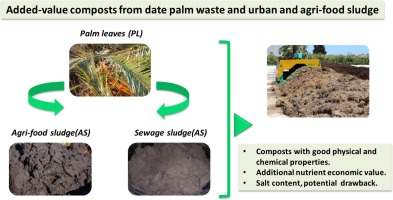Journal of Environmental Management ( IF 8.0 ) Pub Date : 2018-08-13 , DOI: 10.1016/j.jenvman.2018.08.035 A. Vico , M.D. Pérez-Murcia , M.A. Bustamante , E. Agulló , F.C. Marhuenda-Egea , J.A. Sáez , C. Paredes , A. Pérez-Espinosa , R. Moral

|
In the Mediterranean countries, there is an increasing production of date palm wastes (Phoenix dactylifera L.), not only due to the raising production of date palm fruits, but also derived from the maintenance of urban and peri-urban green areas, especially in those affected by red palm weevil (Rhynchophorus ferrugineus). The management of this increasing volume of green wastes usually concludes with a controlled disposal that implies an important loss of resources, in terms of organic matter, nutrients and energy. In addition, the rise of wastewater generation and the incentive of the wastewater treatment processes have derived in an increase of the amount of the sludge produced, which makes difficult its management. This work studies the feasibility of co-composting palm wastes with sludge from the urban and agri-food sectors as alternative treatment to manage these organic waste streams and to obtain added-value compost. For this, four mixtures (P1, P2, P3 and P4) were prepared using as main component palm leave waste (PL) mixed with different types of sludge. In the piles P1, P2 and P3, sewage sludge (SS) was used as co-composting agent, while agri-food sludge (AS) was used in P4. Throughout composting, the thermal profile of the composting piles was assessed, as were physical, chemical, physico-chemical and maturity parameters. In addition, the changes in water-soluble organic matter were assessed using chemical analytical methods and the excitation–emission matrix (EEM) fluorescence spectroscopy. The results obtained showed the viability of the co-composting process to obtain end-products with adequate maturity degree and physical characteristics for their potential use as substrates, except for the salt contents that can limit their use in some agricultural sectors.
中文翻译:

通过与城市污泥和农业食品污泥共同堆肥,对枣椰树(Phoenix dactylifera L.)修剪生物量进行估价
在地中海国家,椰枣废物(Phoenix dactylifera L.)的产量增加,这不仅是由于椰枣果实产量的增加,而且还源于对城市和郊区绿化地区的维护,特别是在那些受红掌象鼻虫(Rhynchophorus ferrugineus)。对这种不断增加的绿色废物的管理通常以可控的处置结束,这意味着在有机物,营养物质和能源方面资源的重大损失。另外,废水产生的增加和废水处理过程的激励导致产生的污泥量增加,这使得其处理变得困难。这项工作研究了将棕榈废料与城市和农业食品部门的污泥共混合作为处理这些有机废料流并获得增值堆肥的替代处理的可行性。为此,使用混合了不同类型污泥的棕榈叶废料(PL)作为主要成分,制备了四种混合物(P1,P2,P3和P4)。在P1,P2和P3堆中,污水污泥(SS)被用作协同堆肥剂,P4中使用了农业食品污泥(AS)。在整个堆肥过程中,评估堆肥堆的热特性,以及物理,化学,物理化学和成熟度参数。此外,使用化学分析方法和激发发射矩阵(EEM)荧光光谱法评估了水溶性有机物的变化。所获得的结果表明,共盐制浆工艺的可行性,以期获得具有足够成熟度和物理特性的最终产品作为潜在的底物,但盐含量可能会限制其在某些农业领域的使用。使用化学分析方法和激发发射矩阵(EEM)荧光光谱法评估了水溶性有机物的变化。所获得的结果表明,共混制过程的可行性是获得具有足够成熟度和物理特性的最终产品以用作潜在的底物,但盐含量可能会限制其在某些农业领域的使用。使用化学分析方法和激发发射矩阵(EEM)荧光光谱法评估了水溶性有机物的变化。所获得的结果表明,共混制过程的可行性是获得具有足够成熟度和物理特性的最终产品以用作潜在的底物,但盐含量可能会限制其在某些农业领域的使用。











































 京公网安备 11010802027423号
京公网安备 11010802027423号